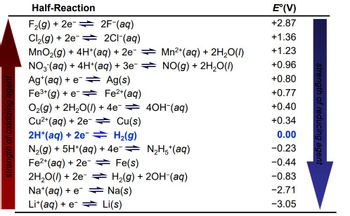The following cell notation contains two half-reactions. Pt | Fe2+ (aq), Fe3+ (aq) || Sn4+ (aq), Sn²+ (aq) | Pt Which of the following statement/equation correctly describes the two half-reactions? anode: Sn4+ (aq)+2e→Sn²+ (aq); cathode: Fe2+(aq)-e→Fe³+(aq); O anode: Fe²+ (aq)-e→Fe³+ (aq); cathode: Sn²+ (aq)+2e→Sn4+ (aq) O anode: Fe³+ (aq)+e→Fe2+ (aq); cathode: Sn²+ (aq)+2e-Sn³+ (aq) anode: Pt + e → Fe³+ (aq)+Fe2+ (aq); cathode: Sn4+ (aq)+Sn²2+ (aq)+2e→Pt O anode: Fe²+ (aq)-e→Fe³+ (aq); cathode: Sn4+ (aq)+2e Sn²+ (aq)
The following cell notation contains two half-reactions. Pt | Fe2+ (aq), Fe3+ (aq) || Sn4+ (aq), Sn²+ (aq) | Pt Which of the following statement/equation correctly describes the two half-reactions? anode: Sn4+ (aq)+2e→Sn²+ (aq); cathode: Fe2+(aq)-e→Fe³+(aq); O anode: Fe²+ (aq)-e→Fe³+ (aq); cathode: Sn²+ (aq)+2e→Sn4+ (aq) O anode: Fe³+ (aq)+e→Fe2+ (aq); cathode: Sn²+ (aq)+2e-Sn³+ (aq) anode: Pt + e → Fe³+ (aq)+Fe2+ (aq); cathode: Sn4+ (aq)+Sn²2+ (aq)+2e→Pt O anode: Fe²+ (aq)-e→Fe³+ (aq); cathode: Sn4+ (aq)+2e Sn²+ (aq)
Chemistry
10th Edition
ISBN:9781305957404
Author:Steven S. Zumdahl, Susan A. Zumdahl, Donald J. DeCoste
Publisher:Steven S. Zumdahl, Susan A. Zumdahl, Donald J. DeCoste
Chapter1: Chemical Foundations
Section: Chapter Questions
Problem 1RQ: Define and explain the differences between the following terms. a. law and theory b. theory and...
Related questions
Question
100%
1a

Transcribed Image Text:The following cell notation contains two half-reactions.
Pt | Fe2+ (aq), Fe3+ (aq) || Sn4+ (aq), Sn²+ (aq) | Pt
Which of the following statement/equation correctly describes the two half-reactions?
anode: Sn4+ (aq)+2e→Sn²+ (aq); cathode: Fe2+(aq)-e→Fe³+(aq);
O anode: Fe²+ (aq)-e→Fe³+(aq); cathode: Sn²+ (aq)+2e→Sn4+ (aq)
anode: Fe³+ (aq)+e→Fe2+ (aq); cathode: Sn²+ (aq)+2e→Sn³+ (aq)
anode: Pt + e → Fe³+ (aq)+Fe2+ (aq); cathode: Sn4+ (aq)+Sn²+ (aq) +2e→Pt
O anode: Fe²+ (aq)-e→Fe³+ (aq); cathode: Sn4+ (aq)+2e-Sn²+ (aq)
Expert Solution
This question has been solved!
Explore an expertly crafted, step-by-step solution for a thorough understanding of key concepts.
This is a popular solution!
Trending now
This is a popular solution!
Step by step
Solved in 2 steps with 2 images

Follow-up Questions
Read through expert solutions to related follow-up questions below.
Follow-up Question
Using data provided in the table of Standard Potentials, calculate standard emf of the cell described in the last question. Please enter your answer with 2 decimals. for example, 1.056 is written as 1.06. Pay attention to the sign.
this is in par to this question thread

Transcribed Image Text:**Half-Reaction Table and Electrode Potentials**
This table presents various half-reactions along with their standard electrode potentials (E°) measured in volts (V). These potentials indicate the tendency of a chemical species to be reduced—the higher the value, the stronger the oxidizing agent. Conversely, lower values imply stronger reducing agents. The table is organized to show this transition from oxidizing to reducing agents.
### Table Details:
#### Half-Reactions and E° Values:
1. **F₂(g) + 2e⁻ → 2F⁻(aq)**
*E° = +2.87 V*
2. **Cl₂(g) + 2e⁻ → 2Cl⁻(aq)**
*E° = +1.36 V*
3. **MnO₂(g) + 4H⁺(aq) + 2e⁻ → Mn²⁺(aq) + 2H₂O(l)**
*E° = +1.23 V*
4. **NO₃⁻(aq) + 4H⁺(aq) + 3e⁻ → NO(g) + 2H₂O(l)**
*E° = +0.96 V*
5. **Ag⁺(aq) + e⁻ → Ag(s)**
*E° = +0.80 V*
6. **Fe³⁺(aq) + e⁻ → Fe²⁺(aq)**
*E° = +0.77 V*
7. **O₂(g) + 2H₂O(l) + 4e⁻ → 4OH⁻(aq)**
*E° = +0.40 V*
8. **Cu²⁺(aq) + 2e⁻ → Cu(s)**
*E° = +0.34 V*
9. **2H⁺(aq) + 2e⁻ → H₂(g)**
*E° = 0.00 V*
10. **N₂(g) + 5H⁺(aq) + 4e⁻ → N₂H₇⁺(aq)**
*E° = −0.23 V*
11. **Fe²⁺(aq) + 2e⁻ → Fe(s)**
Solution
Follow-up Question

Transcribed Image Text:Based on the cell notation given in the last question, write the correct cell reaction?
O Fe³+ (aq) + Sn²+ (aq)
O Fe²+ (aq) + Fe3+ (aq)
O 2Fe2+ (aq) + Sn4+ (aq)
O 2Fe3+ (aq) + Sn²+ (aq)
Fe2+ (aq) + Sn4+ (aq)
Fe2+ (aq) + Sn4+ (aq)
› Sn4+ (aq) + Sn2+ (aq)
2Fe3+ (aq) + Sn2+ (aq)
2Fe2+ (aq) + Sn4+ (aq)
Fe3+ (aq) + Sn²+ (aq)
O
Solution
Knowledge Booster
Learn more about
Need a deep-dive on the concept behind this application? Look no further. Learn more about this topic, chemistry and related others by exploring similar questions and additional content below.Recommended textbooks for you

Chemistry
Chemistry
ISBN:
9781305957404
Author:
Steven S. Zumdahl, Susan A. Zumdahl, Donald J. DeCoste
Publisher:
Cengage Learning

Chemistry
Chemistry
ISBN:
9781259911156
Author:
Raymond Chang Dr., Jason Overby Professor
Publisher:
McGraw-Hill Education

Principles of Instrumental Analysis
Chemistry
ISBN:
9781305577213
Author:
Douglas A. Skoog, F. James Holler, Stanley R. Crouch
Publisher:
Cengage Learning

Chemistry
Chemistry
ISBN:
9781305957404
Author:
Steven S. Zumdahl, Susan A. Zumdahl, Donald J. DeCoste
Publisher:
Cengage Learning

Chemistry
Chemistry
ISBN:
9781259911156
Author:
Raymond Chang Dr., Jason Overby Professor
Publisher:
McGraw-Hill Education

Principles of Instrumental Analysis
Chemistry
ISBN:
9781305577213
Author:
Douglas A. Skoog, F. James Holler, Stanley R. Crouch
Publisher:
Cengage Learning

Organic Chemistry
Chemistry
ISBN:
9780078021558
Author:
Janice Gorzynski Smith Dr.
Publisher:
McGraw-Hill Education

Chemistry: Principles and Reactions
Chemistry
ISBN:
9781305079373
Author:
William L. Masterton, Cecile N. Hurley
Publisher:
Cengage Learning

Elementary Principles of Chemical Processes, Bind…
Chemistry
ISBN:
9781118431221
Author:
Richard M. Felder, Ronald W. Rousseau, Lisa G. Bullard
Publisher:
WILEY